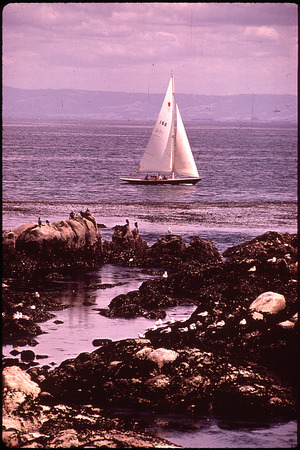Pacific Grove Marine Gardens State Marine Conservation Area facts for kids
The Pacific Grove Marine Gardens State Marine Conservation Area is a special ocean area near Monterey and Pacific Grove, California. It's like an underwater park where marine life is protected. This area is part of a group of four small marine protected areas (MPAs) at the southern end of Monterey Bay. Together, these four areas cover about 2.96 square miles (7.67 square kilometers) of ocean.
In this special conservation area, most fishing and taking of sea creatures is not allowed. However, people can still fish for finfish for fun, and giant and bull kelp can be collected by hand under certain rules. This "Marine Gardens" area is famous for its amazing ocean views, beautiful flowers, and cool tide pools filled with seaweed.
Contents
History of the Protected Area
The Pacific Grove Marine Gardens State Marine Conservation Area was created in September 2007. It was set up by the California Department of Fish & Game. This area was one of the first 29 marine protected areas established during a big project called the Marine Life Protection Act Initiative. This initiative is a team effort involving the public to create a network of protected ocean areas all along California's coastline.
Where is it Located?
The Pacific Grove Marine Gardens SMCA is found off the coast of the Monterey Peninsula. This is at the southern part of Monterey Bay. The protected area covers about 0.93 square miles (2.41 square kilometers). It is right offshore from the Point Pinos Lighthouse.
This conservation area is one of four marine protected areas around the Monterey Peninsula. It sits between the Asilomar State Marine Reserve and the Lovers Point State Marine Reserve. A bit further east, you'll find the Edward F. Ricketts State Marine Conservation Area. All four of these special ocean areas are part of the larger Monterey Bay National Marine Sanctuary.
Ocean Life and Habitats
The Monterey Peninsula is home to many amazing tide pools, which are like small natural aquariums filled with sea creatures. The sandy beaches here are also used by harbor seals to have their pups. Offshore, thick kelp forests provide safe homes and food for sea otters.
The Pacific Grove Marine Gardens SMCA protects a wide variety of marine life. It includes different types of ocean environments such as:
- Kelp forests (like underwater forests)
- Sandy beaches
- Rocky areas where the ocean meets the land
- Soft and hard seafloor areas
Fun Things to Do and See
Millions of people from all over the world visit the Monterey Peninsula each year because of its beautiful nature and ocean resources. More than 65,000 scuba divers come here because it's easy to access the water, there's lots of wildlife, and the kelp forests are incredible.
The Monterey Bay Aquarium is a very popular place to visit. It has a huge living kelp forest exhibit that is 28 feet (8.5 meters) tall! This exhibit shows many of the same species you can find in the nearby marine protected areas. The aquarium also has sea otters, tide pool animals, and sometimes even sea turtles.
Besides diving and visiting the aquarium, people enjoy many other activities in Monterey Bay. These include:
- Kayaking
- Whale watching
- Charter fishing trips
- Surfing
- Bird watching
- Exploring tide pools
- Walking on the beach
The Point Pinos Lighthouse is next to the protected area. It's the oldest lighthouse on the West Coast that has been working continuously.
California's marine protected areas encourage people to enjoy and learn about the ocean. Activities like kayaking, diving, snorkeling, and swimming are usually allowed, unless there are specific rules against them.
Learning from the Ocean: Scientific Monitoring
Scientists are studying some of California's marine protected areas, including those along the central coast. They want to see how well these areas are working and to learn more about the health of our oceans. Similar studies in protected areas near the Santa Barbara Channel Islands have already shown good results, with fish growing larger and their numbers increasing.
Many local science and education groups are involved in this monitoring. These include Stanford University’s Hopkins Marine Station, University of California Santa Cruz, Moss Landing Marine Laboratories, and Cal Poly San Luis Obispo. Scientists use different methods for their research, such as:
- Hook-and-line sampling (catching and releasing fish to study them)
- Surveys of tide pools and underwater areas by scuba divers
- Using special underwater robots called Remote Operated Vehicles (ROVs)




